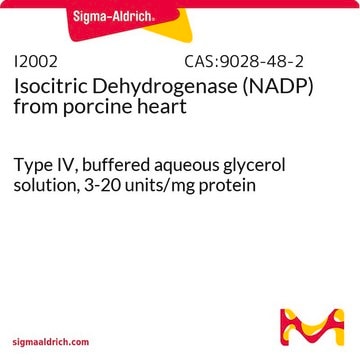I2411
Isocitrate Dehydrogenase 1 (NADP+) human
recombinant, expressed in Sf9 cells, ≥90% (SDS-PAGE)
Synonyme(s) :
IDH1, Isocitrate Dehydrogenase Cytoplasmic
About This Item
Produits recommandés
Produit recombinant
expressed in Sf9 cells
Pureté
≥90% (SDS-PAGE)
Forme
buffered aqueous glycerol solution
Poids mol.
47.6 kDa
Concentration
≥0.30 mg/mL protein (Bradford)
Numéro d'accès NCBI
Maladie(s) pertinente(s)
cancer (lung)
Conditions d'expédition
dry ice
Température de stockage
−70°C
Vous recherchez des produits similaires ? Visite Guide de comparaison des produits
Description générale
Application
Actions biochimiques/physiologiques
Forme physique
Code de la classe de stockage
10 - Combustible liquids
Classe de danger pour l'eau (WGK)
WGK 1
Point d'éclair (°F)
Not applicable
Point d'éclair (°C)
Not applicable
Certificats d'analyse (COA)
Recherchez un Certificats d'analyse (COA) en saisissant le numéro de lot du produit. Les numéros de lot figurent sur l'étiquette du produit après les mots "Lot" ou "Batch".
Déjà en possession de ce produit ?
Retrouvez la documentation relative aux produits que vous avez récemment achetés dans la Bibliothèque de documents.
Les clients ont également consulté
Protocoles
We describe here a rapid and sensitive method to separate and measure D-2-OHG and L-2-OHG enantiomers using high-resolution mass spectrometry (HRMS) detection.
Chromatograms
application for HPLCNotre équipe de scientifiques dispose d'une expérience dans tous les secteurs de la recherche, notamment en sciences de la vie, science des matériaux, synthèse chimique, chromatographie, analyse et dans de nombreux autres domaines..
Contacter notre Service technique









